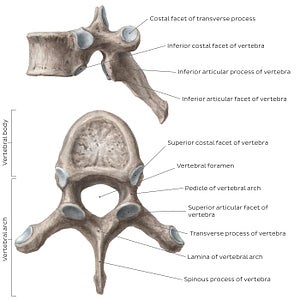Liene Znotina
Typical thoracic vertebra (English)
Typical thoracic vertebra (English)
A typical thoracic vertebra consists of a body, arch, spinous, transverse and superior and inferior articular processes. The body (typically heart-shaped) is larger than those seen in the cervical spine, but smaller than those of lumbar vertebrae. Specific features of thoracic vertebrae are detailed below.Costal facets: Vertebrae T2-T9 bear superior and inferior ‘demifacets’ which are located on the superior and inferior margins of the lateral sides of each vertebral body (therefore, articulation with the head of one rib is shared between adjacent vertebrae. Vertebra T1 features a demifacet along its inferolateral margins, and a whole facet on its superolateral surfaces. Vertebrae T10-T12 features a single whole costal facet on each side of their body.Vertebral arch: The vertebral arches of thoracic vertebrae are more cylindrical and smaller than that in cervical vertebrae. Spinous process: The spinous processes of thoracic vertebrae are elongated, with the angle between the spinous process and the body becoming more acute in lower levels.Transverse processes: feature costal facets for articulation with the tubercle of the ipsilateral numerically equivalent rib (exception: vertebrae T11/T12).Superior and inferior articular processes: superior processes face backward (and slightly lateral/upwards), inferior processes are oriented forward (and slightly medial/downward).
Precio habitual
$7.56 USD
Precio habitual
Precio de oferta
$7.56 USD
Precio unitario
por
No se pudo cargar la disponibilidad de retiro


#91806E
#473D35
#E1D2BF y #CFC0AD

